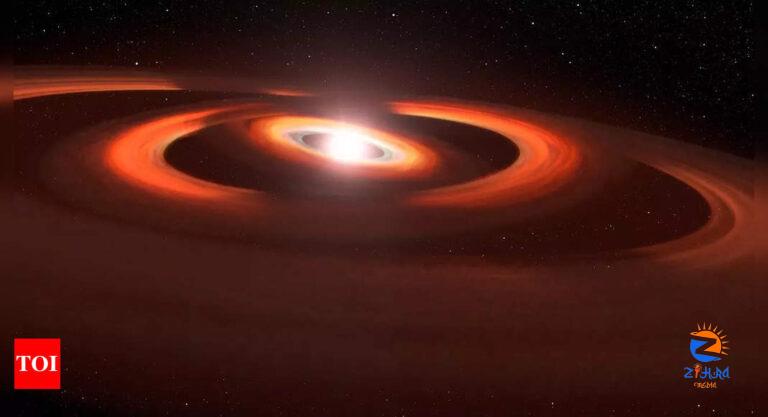
[ad_1]
In a groundbreaking astronomical revelation, scientists have identified compelling evidence of an extended disk composed of dust and gas, swirling in orbit around a distant star, reported Science Alert. What sets this discovery apart is not the typicality of such phenomena in the developmental stages of stars and planetary systems, but rather its unprecedented occurrence around a star located in an entirely different galaxy beyond our own.
The astonishing finding occurred within the Large Magellanic Cloud, a dwarf galaxy positioned a staggering 179,000 light-years away from our Milky Way.While the assumption that star formation processes are universal may seem logical, this marks the initial observation of such intricate celestial occurrences beyond our home galaxy.
Astronomer Anna McLeod from Durham University in the UK expressed her amazement, stating, “When I first saw evidence for a rotating structure in the ALMA data, I could not believe that we had detected the first extragalactic accretion disc; it was a special moment.”
Accretion discs, vital in forming stars and planets, have been extensively studied within our galaxy using the Atacama Large Millimeter/submillimeter Array (ALMA). However, this newfound extragalactic stellar disk sheds light on the previously uncharted territories of star formation in diverse environments.
Stars originate from dense clumps within clouds of molecular gas and dust present in interstellar space. As these clumps grow denser, they collapse under gravity, forming a spinning disk that draws in additional material from the surrounding cloud. The remaining disk material coalesces to form various components of a planetary system, such as planets, asteroids, meteors, comets, and dust.
The discovery was facilitated by the ALMA radio telescope, which has previously imaged numerous disks within the Milky Way. McLeod and her team initiated their quest for an extragalactic stellar disk after the Multi Unit Spectroscopic Explorer (MUSE) instrument on the Very Large Telescope revealed signs of a jet in a system named HH 1177—an indicator of star formation.
Utilizing ALMA to observe signs of rotation, the researchers identified wavelength changes in the emitted light, signifying the star’s movement toward or away from Earth. The analysis revealed a very young and massive star still feeding from its surrounding disk. Notably, the HH 1177 disk was visible in optical wavelengths, a departure from protostellar disks within the Milky Way.
The researchers attribute this difference to the reduced dust content in the Large Magellanic Cloud, allowing the HH 1177 star to be less obscured compared to young, massive Milky Way stars.
The significance of this discovery extends beyond unveiling the intricacies of star formation in different environments. It also provides insights into the constraints that varying environments impose on the overarching process of star formation.
In the words of McLeod, “We are in an era of rapid technological advancement when it comes to astronomical facilities. Being able to study how stars form at such incredible distances and in a different galaxy is very exciting.” This breakthrough heralds a new chapter in our understanding of the cosmic phenomena shaping the universe beyond our familiar celestial confines.
The astonishing finding occurred within the Large Magellanic Cloud, a dwarf galaxy positioned a staggering 179,000 light-years away from our Milky Way.While the assumption that star formation processes are universal may seem logical, this marks the initial observation of such intricate celestial occurrences beyond our home galaxy.
Astronomer Anna McLeod from Durham University in the UK expressed her amazement, stating, “When I first saw evidence for a rotating structure in the ALMA data, I could not believe that we had detected the first extragalactic accretion disc; it was a special moment.”
Accretion discs, vital in forming stars and planets, have been extensively studied within our galaxy using the Atacama Large Millimeter/submillimeter Array (ALMA). However, this newfound extragalactic stellar disk sheds light on the previously uncharted territories of star formation in diverse environments.
Stars originate from dense clumps within clouds of molecular gas and dust present in interstellar space. As these clumps grow denser, they collapse under gravity, forming a spinning disk that draws in additional material from the surrounding cloud. The remaining disk material coalesces to form various components of a planetary system, such as planets, asteroids, meteors, comets, and dust.
The discovery was facilitated by the ALMA radio telescope, which has previously imaged numerous disks within the Milky Way. McLeod and her team initiated their quest for an extragalactic stellar disk after the Multi Unit Spectroscopic Explorer (MUSE) instrument on the Very Large Telescope revealed signs of a jet in a system named HH 1177—an indicator of star formation.
Utilizing ALMA to observe signs of rotation, the researchers identified wavelength changes in the emitted light, signifying the star’s movement toward or away from Earth. The analysis revealed a very young and massive star still feeding from its surrounding disk. Notably, the HH 1177 disk was visible in optical wavelengths, a departure from protostellar disks within the Milky Way.
The researchers attribute this difference to the reduced dust content in the Large Magellanic Cloud, allowing the HH 1177 star to be less obscured compared to young, massive Milky Way stars.
The significance of this discovery extends beyond unveiling the intricacies of star formation in different environments. It also provides insights into the constraints that varying environments impose on the overarching process of star formation.
In the words of McLeod, “We are in an era of rapid technological advancement when it comes to astronomical facilities. Being able to study how stars form at such incredible distances and in a different galaxy is very exciting.” This breakthrough heralds a new chapter in our understanding of the cosmic phenomena shaping the universe beyond our familiar celestial confines.
[ad_2]
